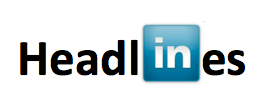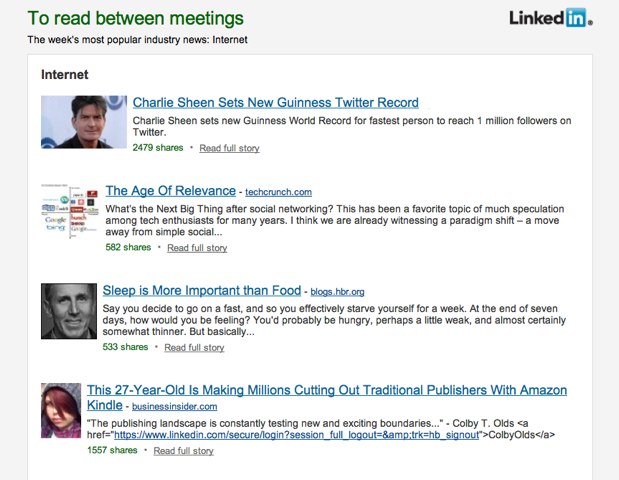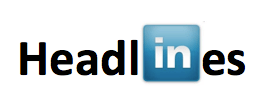
Editor’s note: The following guest post was written by Mrinal Desai, an early employee of LinkedIn who is also co-founder of CrossLoop and addappt. You can follow him on Twitter.
A lot has been written about social news and how Twitter and Facebook are in the running for defining and dominating it. There’s also a lot of hand-wringing about how journalism will be disrupted by social.
I might be a bit biased as a former employee, but when it comes to social news, I think LinkedIn could become the Wall Street Journal of social news—not Twitter or Facebook. In fact, LinkedIn is expected to announce a new social news product this week. In what may or may not be a precursor to that anticipated product, a few days ago I received a curious email from “LinkedIn Headlines” (the actual email address news@linkedin.com). It was an email digest of the most shared news in my network about the Internet industry (see screenshot below). There has been no official launch of a product by that name nor have I seen anyone else write about it. But that email made me think a little more about the different types of news I consume.
I write this post from a perspective of a news addict—I wrote a guest post here on TechCrunch called Screening the News and am known on Twitter as a “tech news junkie”. No matter what the source, eventually all news is curated—just differently.
The Curation Types are:
- By The Editor/writer: Blogs, physical magazines and newspapers that I read like Fortune, The Economist and The Wall Street Journal
- By my network: Twitter, FlipBoard, Facebook
- By Editors and Algorithms (based on “popularity” amongst writers): Techmeme
- By Algorithm: Google News and then finally
- By Editor and popularity of the general audience via most read, commented, emailed, retweeted, or liked: TechCrunch, nytimes.com, wsj.com
- By general popularity only: possibly bit.ly, tweetmeme
I started networking building long-term relationships consciously when I was “vocationally challenged” in the last dotcom bust. News was the single biggest tool I used to engage people I wanted to know well over the long-term during that time. I don’t do short-term relationships well. In other words, without knowing it, I was behaving like their personal curator over the long term. Understanding my ‘audience’s’ requirements was of paramount importance. Tending to my relationships, independent of business agendas, has always been a priority for me.
Based on my own personal experience, I think LinkedIn has a significant opportunity in an industry reeling with disruption. It has many parallels in terms of audience with the top daily print publication, The Wall Street Journal. A publication focused primarily on business, the WSJ grew circulation 1.8% last year, when the rest of the newspaper industry’s fell by 4.46%.
LinkedIn could bring curation by popularity within my network: there is absolutely nothing that does that for me today. And since it is much more structured by industry and work interests, it has the potential to become the ultimate business news filter. How could LinkedIn make social news better?
- LinkedIn can suddenly become an information network, something that Twitter likes to call itself but with analytics built in based on my network
- Fred Wilson wrote a post comparing Techmeme and Hacker News for the technology industry. Suddenly LinkedIn can bring users both with an ability to slice a vertical from the highly technical to more general news about companies like Apple or Google
- LinkedIn could help me learn about the sources of news that is important to my network. This can lead to discovery and further curation
- LinkedIn could bring a personalized newspaper that I can change based on industries that its users come from. For example, venture capital from people who have worked in venture capital.
- With the recent introduction of “Skills” by LinkedIn, readers could find news that helps them develop a skill they care about. For example: If I wanted to dig deeper into learning about SEO, LinkedIn could bring stories from sites like SearchEngineLand
- Based on the structured data from my profile including industry, companies, and job title, LinkedIn could recommend great articles to me
- Trending—this is a no brainer. Apart from my profile information and my network, LinkedIn Headlines can also leverage industry groups I belong to on LinkedIn
- Significantly enhance Twitter. LinkedIn enabled Twitter sync last year and from what I see in my network, many have autosynced their tweets and a majority, which should come as no surprise, are links. With analytics, LinkedIn could surface shared URLs that are most popular within my network
- Like the Priority Inbox, LinkedIn could help me mark some users as important so that I get the news they shared first. I have many favorite reporters and respected colleagues. I would love to see their stories independent from the “wisdom of the crowd”
- Since LinkedIn enables me to save a search for Jobs or get Email Alerts, it could also send me news around particular companies or the industries
- LinkedIn could show me the all connections around the link/ news article—a little like Facebook’s ‘Like’ but in a “magazine” format
Can Twitter do some of this this? Maybe sharing analytics but it lacks the deep industry and profile information that LinkedIn houses to build a powerful and personal recommendation engine. Can Facebook do this? Maybe with some sharing analytics but again, it does not have the deep business profiles that LinkedIn has amassed. And personally I really do not care about Justin Bieber or Charlie Sheen, although I am sure they will pop up even in LinkedIn headlines.

